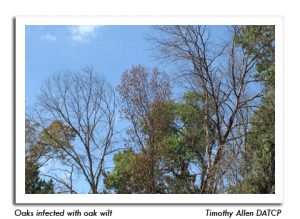Heads Up: Time to Check Your Oaks

If you have oak trees on your property, this is the time of year to cruise the woodlot and look for signs of oak wilt. Once a tree becomes infected, an entire stand can be affected because the disease moves across root grafts from one tree to the next. Oak wilt has been confirmed in 61 of Wisconsin’s 72 counties.
The Wisconsin DNR has a quick online Oak Wilt Guide that can help you assess your oak wilt risk. Now is the time to identify oak wilt if it exists on your land and make plans for dealing with it this coming winter.
According to the Wisconsin Department of Agriculture, Trade and Consumer Protection, oak wilt is transmitted by a beetle that is attracted to sap from open wounds. This beetle carries the oak wilt fungus (Ceratocystis fagacearum). That is why it is very important that landowners only prune oaks during the dormant season; late fall through mid-winter. Trees should not be pruned during April, May, or June or whenever the beetles are active.
There is no cure for infected trees. According to the US Forest Service, the only control action available is to isolate infected trees by cutting any root grafts between infected and uninfected trees. A trencher or vibrating plow set to 2-4 feet deep separates the root systems of adjacent oaks, preventing underground spread.
Infected trees should be cut down before April 1st; burned, chipped or covered with plastic for sixty days to prevent overhead spread of the beetles and fungus. New sprouts from infected roots need to be controlled with herbicide.
UW Extension has an informative Oak Wilt Bulletin that provides useful information about the pest; its diagnosis and control.For more information, contact the Wisconsin DNR Forest Health Staff.
